RedHat ex300 practice test
Red Hat Certified Engineer (RHCE)
Question 1
CORRECT TEXT
RHCE Test Configuration Instructions
Information for the two systems you will use in test is the following:
system1.group3.example.com: is one of the main sever. system2.group3.example.com:
mainly used as a client.
Password for both of the two systems is atenorth
System’s IP is provided by DHCP, you can regard it as normal, or you can reset to Static IP
in accordance with the following requirements:
system1.group3.example.com: 172.24.3.5
system2.group3.example.com: 172.24.3.10
The subnet mask is 255.255.255.0
Your system is a member of DNS domain group3.example.com. All systems in DNS domain
group3.example.com are all in subnet 172.24.3.0/255.255.255.0, the same all systems in this
subnet are also in group3.example.com, unless specialized, all network services required to
be configured can be accessed by systems of domain group3.
host.group3.example.com provides a centralized authentication service domain
GROUP3.EXAMPLE.COM, both system1 and system2 have already been pre-configured to
be the client for this domain, this domain provides the following user account:
Firewall is enabled by default, you can turn it off when deemed appropriate, other settings
about firewall may be in separate requirements.
Your system will be restarted before scoring, so please ensure that all modifications and
service configurations you made still can be operated after the restart without manual
intervention, virtual machine instances of all examinations must be able to enter the correct
multi-user level after restart without manual assistance, it will be scored zero if the test using
virtual machine system cannot be restarted or be properly restarted.
Corresponding distribution packages for the testing using operating system Red Hat
Enterprise Linux version can be found in the following link:
http://server1.group3.example.com/rhel
Part of the requirements include host security, ensure your host security limit does not
prevent the request to allow the host and network, although you correctly configured the
network service but would have to allow the host or network is blocked, this also does not
score.
You will notice that some requirements which clearly do not allow services be accessed by
service domain my133t.org, systems of this domain are in subnet 172.25.1.0/252.255.255.0,
and systems of these subnets also belong to my 133t.org domain.
PS: Notice that some test questions may depend on other exam questions, for example, you
might be asked to perform a series of restrictions on a user, but this user creation may be
required in other questions. For convenient identification, each exam question has some radio
buttons to help you identify which questions you have already completed or not completed.
Certainly, you do not need to care these buttons if you don’t need them.
Configure SELINUX
Modify the state of selinux to Enforcing mode.
Use VIM /etc/selinux
Answer:
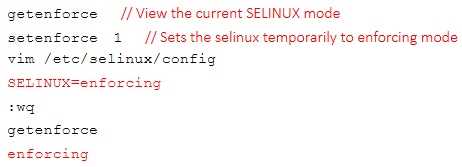
Question 2
CORRECT TEXT
RHCE Test Configuration Instructions
Information for the two systems you will use in test is the following:
system1.group3.example.com: is one of the main sever. system2.group3.example.com:
mainly used as a client.
Password for both of the two systems is atenorth
System’s IP is provided by DHCP, you can regard it as normal, or you can reset to Static IP
in accordance with the following requirements:
system1.group3.example.com: 172.24.3.5
system2.group3.example.com: 172.24.3.10
The subnet mask is 255.255.255.0
Your system is a member of DNS domain group3.example.com. All systems in DNS domain
group3.example.com are all in subnet 172.24.3.0/255.255.255.0, the same all systems in this
subnet are also in group3.example.com, unless specialized, all network services required to
be configured can be accessed by systems of domain group3.
host.group3.example.com provides a centralized authentication service domain
GROUP3.EXAMPLE.COM, both system1 and system2 have already been pre-configured to
be the client for this domain, this domain provides the following user account:
Firewall is enabled by default, you can turn it off when deemed appropriate, other settings
about firewall may be in separate requirements.
Your system will be restarted before scoring, so please ensure that all modifications and
service configurations you made still can be operated after the restart without manual
intervention, virtual machine instances of all examinations must be able to enter the correct
multi-user level after restart without manual assistance, it will be scored zero if the test using
virtual machine system cannot be restarted or be properly restarted.
Corresponding distribution packages for the testing using operating system Red Hat
Enterprise Linux version can be found in the following link:
http://server1.group3.example.com/rhel
Part of the requirements include host security, ensure your host security limit does not
prevent the request to allow the host and network, although you correctly configured the
network service but would have to allow the host or network is blocked, this also does not
score.
You will notice that some requirements which clearly do not allow services be accessed by
service domain my133t.org, systems of this domain are in subnet 172.25.1.0/252.255.255.0,
and systems of these subnets also belong to my 133t.org domain.
PS: Notice that some test questions may depend on other exam questions, for example, you
might be asked to perform a series of restrictions on a user, but this user creation may be
required in other questions. For convenient identification, each exam question has some radio
buttons to help you identify which questions you have already completed or not completed.
Certainly, you do not need to care these buttons if you don’t need them.
Configure the SSH Access as required:
Users can visit your two virtual machine systems via clients of domain group3.example.com
through SSH remote.
Answer:
Modify file /etc/hosts.allow
172.24.11.
Modify file /etc/hosts.deny
172.25.0.
Both of them need to be configured.
Add a firewall
firewall-cmd –zone=block --add-source=172.25.11.0/24 --permanent firewall-cmd –reload
Both of them need to be configured
Question 3
CORRECT TEXT
RHCE Test Configuration Instructions
Information for the two systems you will use in test is the following:
system1.group3.example.com: is one of the main sever. system2.group3.example.com:
mainly used as a client.
Password for both of the two systems is atenorth
System’s IP is provided by DHCP, you can regard it as normal, or you can reset to Static IP
in accordance with the following requirements:
system1.group3.example.com: 172.24.3.5
system2.group3.example.com: 172.24.3.10
The subnet mask is 255.255.255.0
Your system is a member of DNS domain group3.example.com. All systems in DNS domain
group3.example.com are all in subnet 172.24.3.0/255.255.255.0, the same all systems in this
subnet are also in group3.example.com, unless specialized, all network services required to
be configured can be accessed by systems of domain group3.
host.group3.example.com provides a centralized authentication service domain
GROUP3.EXAMPLE.COM, both system1 and system2 have already been pre-configured to
be the client for this domain, this domain provides the following user account:
Firewall is enabled by default, you can turn it off when deemed appropriate, other settings
about firewall may be in separate requirements.
Your system will be restarted before scoring, so please ensure that all modifications and
service configurations you made still can be operated after the restart without manual
intervention, virtual machine instances of all examinations must be able to enter the correct
multi-user level after restart without manual assistance, it will be scored zero if the test using
virtual machine system cannot be restarted or be properly restarted.
Corresponding distribution packages for the testing using operating system Red Hat
Enterprise Linux version can be found in the following link:
http://server1.group3.example.com/rhel
Part of the requirements include host security, ensure your host security limit does not
prevent the request to allow the host and network, although you correctly configured the
network service but would have to allow the host or network is blocked, this also does not
score.
You will notice that some requirements which clearly do not allow services be accessed by
service domain my133t.org, systems of this domain are in subnet 172.25.1.0/252.255.255.0,
and systems of these subnets also belong to my 133t.org domain.
PS: Notice that some test questions may depend on other exam questions, for example, you
might be asked to perform a series of restrictions on a user, but this user creation may be
required in other questions. For convenient identification, each exam question has some radio
buttons to help you identify which questions you have already completed or not completed.
Certainly, you do not need to care these buttons if you don’t need them.
Customize the User Environment
Create a custom command on system1 and system2 named as qstat, and this custom
command will execute the following command:
/bin/ps - Aopid,tt,user,fname,rsz
This command is valid for all users in the system.
Answer:

// You need to configure that on both two systems -
Question 4
CORRECT TEXT
RHCE Test Configuration Instructions
Information for the two systems you will use in test is the following:
system1.group3.example.com: is one of the main sever. system2.group3.example.com:
mainly used as a client.
Password for both of the two systems is atenorth
System’s IP is provided by DHCP, you can regard it as normal, or you can reset to Static IP
in accordance with the following requirements:
system1.group3.example.com: 172.24.3.5
system2.group3.example.com: 172.24.3.10
The subnet mask is 255.255.255.0
Your system is a member of DNS domain group3.example.com. All systems in DNS domain
group3.example.com are all in subnet 172.24.3.0/255.255.255.0, the same all systems in this
subnet are also in group3.example.com, unless specialized, all network services required to
be configured can be accessed by systems of domain group3.
host.group3.example.com provides a centralized authentication service domain
GROUP3.EXAMPLE.COM, both system1 and system2 have already been pre-configured to
be the client for this domain, this domain provides the following user account:
Firewall is enabled by default, you can turn it off when deemed appropriate, other settings
about firewall may be in separate requirements.
Your system will be restarted before scoring, so please ensure that all modifications and
service configurations you made still can be operated after the restart without manual
intervention, virtual machine instances of all examinations must be able to enter the correct
multi-user level after restart without manual assistance, it will be scored zero if the test using
virtual machine system cannot be restarted or be properly restarted.
Corresponding distribution packages for the testing using operating system Red Hat
Enterprise Linux version can be found in the following link:
http://server1.group3.example.com/rhel
Part of the requirements include host security, ensure your host security limit does not
prevent the request to allow the host and network, although you correctly configured the
network service but would have to allow the host or network is blocked, this also does not
score.
You will notice that some requirements which clearly do not allow services be accessed by
service domain my133t.org, systems of this domain are in subnet 172.25.1.0/252.255.255.0,
and systems of these subnets also belong to my 133t.org domain.
PS: Notice that some test questions may depend on other exam questions, for example, you
might be asked to perform a series of restrictions on a user, but this user creation may be
required in other questions. For convenient identification, each exam question has some radio
buttons to help you identify which questions you have already completed or not completed.
Certainly, you do not need to care these buttons if you don’t need them.
Configure port forwarding on the system1, as required:
1. The systems in the network 172.24.11.0/24, local port 5423 for accessing system1 will be
forwarded to 80
(2) This setting must be permanent
Answer:
Use Graphical interface to configure
Use firewall-config to open the Graphical interface in CLI
drop-down menu to permanent
Add a strategy to the public area of the “Port Forwarding”
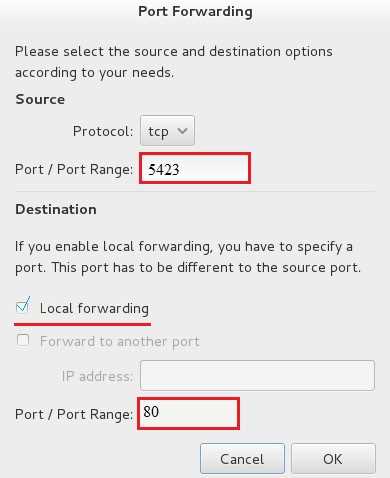
systemctl restart firewalld.service // Reload the firewall strategy
Question 5
CORRECT TEXT
RHCE Test Configuration Instructions
Information for the two systems you will use in test is the following:
system1.group3.example.com: is one of the main sever. system2.group3.example.com:
mainly used as a client.
Password for both of the two systems is atenorth
System’s IP is provided by DHCP, you can regard it as normal, or you can reset to Static IP
in accordance with the following requirements:
system1.group3.example.com: 172.24.3.5
system2.group3.example.com: 172.24.3.10
The subnet mask is 255.255.255.0
Your system is a member of DNS domain group3.example.com. All systems in DNS domain
group3.example.com are all in subnet 172.24.3.0/255.255.255.0, the same all systems in this
subnet are also in group3.example.com, unless specialized, all network services required to
be configured can be accessed by systems of domain group3.
host.group3.example.com provides a centralized authentication service domain
GROUP3.EXAMPLE.COM, both system1 and system2 have already been pre-configured to
be the client for this domain, this domain provides the following user account:
Firewall is enabled by default, you can turn it off when deemed appropriate, other settings
about firewall may be in separate requirements.
Your system will be restarted before scoring, so please ensure that all modifications and
service configurations you made still can be operated after the restart without manual
intervention, virtual machine instances of all examinations must be able to enter the correct
multi-user level after restart without manual assistance, it will be scored zero if the test using
virtual machine system cannot be restarted or be properly restarted.
Corresponding distribution packages for the testing using operating system Red Hat
Enterprise Linux version can be found in the following link:
http://server1.group3.example.com/rhel
Part of the requirements include host security, ensure your host security limit does not
prevent the request to allow the host and network, although you correctly configured the
network service but would have to allow the host or network is blocked, this also does not
score.
You will notice that some requirements which clearly do not allow services be accessed by
service domain my133t.org, systems of this domain are in subnet 172.25.1.0/252.255.255.0,
and systems of these subnets also belong to my 133t.org domain.
PS: Notice that some test questions may depend on other exam questions, for example, you
might be asked to perform a series of restrictions on a user, but this user creation may be
required in other questions. For convenient identification, each exam question has some radio
buttons to help you identify which questions you have already completed or not completed.
Certainly, you do not need to care these buttons if you don’t need them.
Configure Link Aggregation
Configure a link between systeml.group3.example.com and system2. group3.example.com as
required:
This link uses interfaces eth1 and eth2
This link still can work when one interface failes
This link uses the following address 172.16.3.20/255.255.255.0 on systeml
This link uses the following address 172.16.3.25/255.255.255.0 on system2
This link remains normal after the system is restarted
Answer:
If you forget how to write the name, you can search examples in /var/share/doc/team-
1.9/example_configs/
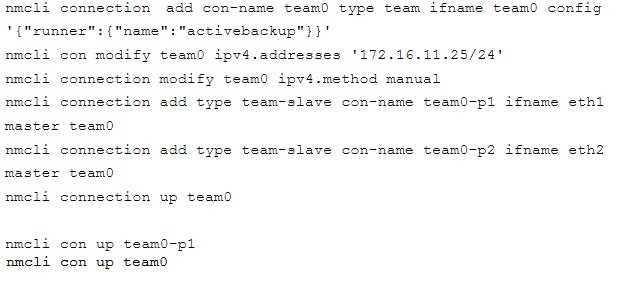
Question 6
CORRECT TEXT
RHCE Test Configuration Instructions
Information for the two systems you will use in test is the following:
system1.group3.example.com: is one of the main sever. system2.group3.example.com:
mainly used as a client.
Password for both of the two systems is atenorth
System’s IP is provided by DHCP, you can regard it as normal, or you can reset to Static IP
in accordance with the following requirements:
system1.group3.example.com: 172.24.3.5
system2.group3.example.com: 172.24.3.10
The subnet mask is 255.255.255.0
Your system is a member of DNS domain group3.example.com. All systems in DNS domain
group3.example.com are all in subnet 172.24.3.0/255.255.255.0, the same all systems in this
subnet are also in group3.example.com, unless specialized, all network services required to
be configured can be accessed by systems of domain group3.
host.group3.example.com provides a centralized authentication service domain
GROUP3.EXAMPLE.COM, both system1 and system2 have already been pre-configured to
be the client for this domain, this domain provides the following user account:
Firewall is enabled by default, you can turn it off when deemed appropriate, other settings
about firewall may be in separate requirements.
Your system will be restarted before scoring, so please ensure that all modifications and
service configurations you made still can be operated after the restart without manual
intervention, virtual machine instances of all examinations must be able to enter the correct
multi-user level after restart without manual assistance, it will be scored zero if the test using
virtual machine system cannot be restarted or be properly restarted.
Corresponding distribution packages for the testing using operating system Red Hat
Enterprise Linux version can be found in the following link:
http://server1.group3.example.com/rhel
Part of the requirements include host security, ensure your host security limit does not
prevent the request to allow the host and network, although you correctly configured the
network service but would have to allow the host or network is blocked, this also does not
score.
You will notice that some requirements which clearly do not allow services be accessed by
service domain my133t.org, systems of this domain are in subnet 172.25.1.0/252.255.255.0,
and systems of these subnets also belong to my 133t.org domain.
PS: Notice that some test questions may depend on other exam questions, for example, you
might be asked to perform a series of restrictions on a user, but this user creation may be
required in other questions. For convenient identification, each exam question has some radio
buttons to help you identify which questions you have already completed or not completed.
Certainly, you do not need to care these buttons if you don’t need them.
Configure IPV6 Address
Configure interface eth0 on your test system, using the following IPV6 addresses:
1) The address of system1 should be 2003:ac18::305/64
(2) The address of system2 should be 2003:ac18::30a/64
(3) Both two systems must be able to communicate with systems in network 2003:ac18/64
(4) The address must still take effect after restart
(5) Both two systems must maintain the current Ipv4 address and can communicate
Answer:
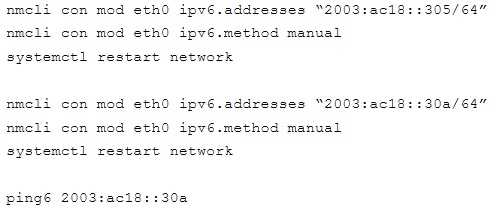
Question 7
CORRECT TEXT
RHCE Test Configuration Instructions
Information for the two systems you will use in test is the following:
system1.group3.example.com: is one of the main sever. system2.group3.example.com:
mainly used as a client.
Password for both of the two systems is atenorth
System’s IP is provided by DHCP, you can regard it as normal, or you can reset to Static IP
in accordance with the following requirements:
system1.group3.example.com: 172.24.3.5
system2.group3.example.com: 172.24.3.10
The subnet mask is 255.255.255.0
Your system is a member of DNS domain group3.example.com. All systems in DNS domain
group3.example.com are all in subnet 172.24.3.0/255.255.255.0, the same all systems in this
subnet are also in group3.example.com, unless specialized, all network services required to
be configured can be accessed by systems of domain group3.
host.group3.example.com provides a centralized authentication service domain
GROUP3.EXAMPLE.COM, both system1 and system2 have already been pre-configured to
be the client for this domain, this domain provides the following user account:
Firewall is enabled by default, you can turn it off when deemed appropriate, other settings
about firewall may be in separate requirements.
Your system will be restarted before scoring, so please ensure that all modifications and
service configurations you made still can be operated after the restart without manual
intervention, virtual machine instances of all examinations must be able to enter the correct
multi-user level after restart without manual assistance, it will be scored zero if the test using
virtual machine system cannot be restarted or be properly restarted.
Corresponding distribution packages for the testing using operating system Red Hat
Enterprise Linux version can be found in the following link:
http://server1.group3.example.com/rhel
Part of the requirements include host security, ensure your host security limit does not
prevent the request to allow the host and network, although you correctly configured the
network service but would have to allow the host or network is blocked, this also does not
score.
You will notice that some requirements which clearly do not allow services be accessed by
service domain my133t.org, systems of this domain are in subnet 172.25.1.0/252.255.255.0,
and systems of these subnets also belong to my 133t.org domain.
PS: Notice that some test questions may depend on other exam questions, for example, you
might be asked to perform a series of restrictions on a user, but this user creation may be
required in other questions. For convenient identification, each exam question has some radio
buttons to help you identify which questions you have already completed or not completed.
Certainly, you do not need to care these buttons if you don’t need them.
Configure the Local Mail Service
Configure the mail service on system1 and system2, as required:
1. These systems do not accept external sending mails
2. Any mails sent locally are automatically routed to rhgls.domain11.example.com
3. Mails sent from these systems will be displayed from rhgls.domain11.example.com
4. You can send mail to local user ‘arthur’ to test your configuration system
rhgls.domain11.example.com
5. You have already configured this user’s mail to the following URL
rhgls.domain11.example.com/received_mail/11
Answer:
solution
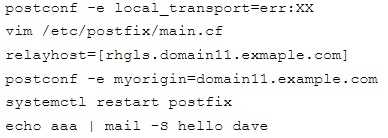
Open rhgls.domain11.example.com/received_mail/11 in a browser
Question 8
CORRECT TEXT
RHCE Test Configuration Instructions
Information for the two systems you will use in test is the following:
system1.group3.example.com: is one of the main sever. system2.group3.example.com:
mainly used as a client.
Password for both of the two systems is atenorth
System’s IP is provided by DHCP, you can regard it as normal, or you can reset to Static IP
in accordance with the following requirements:
system1.group3.example.com: 172.24.3.5
system2.group3.example.com: 172.24.3.10
The subnet mask is 255.255.255.0
Your system is a member of DNS domain group3.example.com. All systems in DNS domain
group3.example.com are all in subnet 172.24.3.0/255.255.255.0, the same all systems in this
subnet are also in group3.example.com, unless specialized, all network services required to
be configured can be accessed by systems of domain group3.
host.group3.example.com provides a centralized authentication service domain
GROUP3.EXAMPLE.COM, both system1 and system2 have already been pre-configured to
be the client for this domain, this domain provides the following user account:
Firewall is enabled by default, you can turn it off when deemed appropriate, other settings
about firewall may be in separate requirements.
Your system will be restarted before scoring, so please ensure that all modifications and
service configurations you made still can be operated after the restart without manual
intervention, virtual machine instances of all examinations must be able to enter the correct
multi-user level after restart without manual assistance, it will be scored zero if the test using
virtual machine system cannot be restarted or be properly restarted.
Corresponding distribution packages for the testing using operating system Red Hat
Enterprise Linux version can be found in the following link:
http://server1.group3.example.com/rhel
Part of the requirements include host security, ensure your host security limit does not
prevent the request to allow the host and network, although you correctly configured the
network service but would have to allow the host or network is blocked, this also does not
score.
You will notice that some requirements which clearly do not allow services be accessed by
service domain my133t.org, systems of this domain are in subnet 172.25.1.0/252.255.255.0,
and systems of these subnets also belong to my 133t.org domain.
PS: Notice that some test questions may depend on other exam questions, for example, you
might be asked to perform a series of restrictions on a user, but this user creation may be
required in other questions. For convenient identification, each exam question has some radio
buttons to help you identify which questions you have already completed or not completed.
Certainly, you do not need to care these buttons if you don’t need them.
Share directories via SMB.
Configure the SMB service on the system1.
Your SMB server must be a member of the STAFF Working Group.
Share the folder /common and the name must be common.
Only clients of domain11.example.com can access the common share.
Common must be able to browse.
User Andy must be able to read the content of the share, if necessary, verification code is
redhat.
Answer:


Question 9
CORRECT TEXT
RHCE Test Configuration Instructions
Information for the two systems you will use in test is the following:
system1.group3.example.com: is one of the main sever. system2.group3.example.com:
mainly used as a client.
Password for both of the two systems is atenorth
System’s IP is provided by DHCP, you can regard it as normal, or you can reset to Static IP
in accordance with the following requirements:
system1.group3.example.com: 172.24.3.5
system2.group3.example.com: 172.24.3.10
The subnet mask is 255.255.255.0
Your system is a member of DNS domain group3.example.com. All systems in DNS domain
group3.example.com are all in subnet 172.24.3.0/255.255.255.0, the same all systems in this
subnet are also in group3.example.com, unless specialized, all network services required to
be configured can be accessed by systems of domain group3.
host.group3.example.com provides a centralized authentication service domain
GROUP3.EXAMPLE.COM, both system1 and system2 have already been pre-configured to
be the client for this domain, this domain provides the following user account:
Firewall is enabled by default, you can turn it off when deemed appropriate, other settings
about firewall may be in separate requirements.
Your system will be restarted before scoring, so please ensure that all modifications and
service configurations you made still can be operated after the restart without manual
intervention, virtual machine instances of all examinations must be able to enter the correct
multi-user level after restart without manual assistance, it will be scored zero if the test using
virtual machine system cannot be restarted or be properly restarted.
Corresponding distribution packages for the testing using operating system Red Hat
Enterprise Linux version can be found in the following link:
http://server1.group3.example.com/rhel
Part of the requirements include host security, ensure your host security limit does not
prevent the request to allow the host and network, although you correctly configured the
network service but would have to allow the host or network is blocked, this also does not
score.
You will notice that some requirements which clearly do not allow services be accessed by
service domain my133t.org, systems of this domain are in subnet 172.25.1.0/252.255.255.0,
and systems of these subnets also belong to my 133t.org domain.
PS: Notice that some test questions may depend on other exam questions, for example, you
might be asked to perform a series of restrictions on a user, but this user creation may be
required in other questions. For convenient identification, each exam question has some radio
buttons to help you identify which questions you have already completed or not completed.
Certainly, you do not need to care these buttons if you don’t need them.
Configure Multi-User SMB Mounts.
Share the directory /devops through SMB on the systeml, as required:
1. The share name is devops
2. The shared directory devops just can be used by clients in domain11.example.com
3. The shared directory devop must be able to be browsed
4. User silene must be able to access this share through read, access code is redhat
5. User akira must be able to access this share through read and write, access code is redhat
6. This share permanently mount to system2. domain11.example.com the user /mnt/dev,
make user silene as authentication any users can get temporary write permissions from akira
Answer:
system1
:
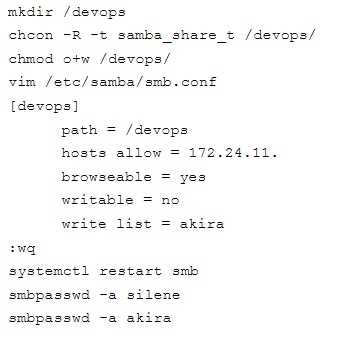

Switch to user akira on the system2, access to /mnt/dev and view files
suakira cd /mnt/dev
lscifscreds add
system1 touch 1
Question 10
CORRECT TEXT
RHCE Test Configuration Instructions
Information for the two systems you will use in test is the following:
system1.group3.example.com: is one of the main sever. system2.group3.example.com:
mainly used as a client.
Password for both of the two systems is atenorth
System’s IP is provided by DHCP, you can regard it as normal, or you can reset to Static IP
in accordance with the following requirements:
system1.group3.example.com: 172.24.3.5
system2.group3.example.com: 172.24.3.10
The subnet mask is 255.255.255.0
Your system is a member of DNS domain group3.example.com. All systems in DNS domain
group3.example.com are all in subnet 172.24.3.0/255.255.255.0, the same all systems in this
subnet are also in group3.example.com, unless specialized, all network services required to
be configured can be accessed by systems of domain group3.
host.group3.example.com provides a centralized authentication service domain
GROUP3.EXAMPLE.COM, both system1 and system2 have already been pre-configured to
be the client for this domain, this domain provides the following user account:
Firewall is enabled by default, you can turn it off when deemed appropriate, other settings
about firewall may be in separate requirements.
Your system will be restarted before scoring, so please ensure that all modifications and
service configurations you made still can be operated after the restart without manual
intervention, virtual machine instances of all examinations must be able to enter the correct
multi-user level after restart without manual assistance, it will be scored zero if the test using
virtual machine system cannot be restarted or be properly restarted.
Corresponding distribution packages for the testing using operating system Red Hat
Enterprise Linux version can be found in the following link:
http://server1.group3.example.com/rhel
Part of the requirements include host security, ensure your host security limit does not
prevent the request to allow the host and network, although you correctly configured the
network service but would have to allow the host or network is blocked, this also does not
score.
You will notice that some requirements which clearly do not allow services be accessed by
service domain my133t.org, systems of this domain are in subnet 172.25.1.0/252.255.255.0,
and systems of these subnets also belong to my 133t.org domain.
PS: Notice that some test questions may depend on other exam questions, for example, you
might be asked to perform a series of restrictions on a user, but this user creation may be
required in other questions. For convenient identification, each exam question has some radio
buttons to help you identify which questions you have already completed or not completed.
Certainly, you do not need to care these buttons if you don’t need them.
Configure NFS service
Configure the NFS service on the system1, as required:
1. Share the directory /public in read only way, just can be accessed by systems in
domain11.example.com at the same time.
2. Share the directory /protected in rad and write way, Kerberos security encryption required,
you can use the key provided by the following URL:
http://host.domain11.example.com/materials/nfs_server.keytab
3. The directory /protected should contain the sub directory named project and the owner
name is deepak;
4. User deepak can access /protected/project in read and write ways
Answer:

Question 11
CORRECT TEXT
RHCE Test Configuration Instructions
Information for the two systems you will use in test is the following:
system1.group3.example.com: is one of the main sever. system2.group3.example.com:
mainly used as a client.
Password for both of the two systems is atenorth
System’s IP is provided by DHCP, you can regard it as normal, or you can reset to Static IP
in accordance with the following requirements:
system1.group3.example.com: 172.24.3.5
system2.group3.example.com: 172.24.3.10
The subnet mask is 255.255.255.0
Your system is a member of DNS domain group3.example.com. All systems in DNS domain
group3.example.com are all in subnet 172.24.3.0/255.255.255.0, the same all systems in this
subnet are also in group3.example.com, unless specialized, all network services required to
be configured can be accessed by systems of domain group3.
host.group3.example.com provides a centralized authentication service domain
GROUP3.EXAMPLE.COM, both system1 and system2 have already been pre-configured to
be the client for this domain, this domain provides the following user account:
Firewall is enabled by default, you can turn it off when deemed appropriate, other settings
about firewall may be in separate requirements.
Your system will be restarted before scoring, so please ensure that all modifications and
service configurations you made still can be operated after the restart without manual
intervention, virtual machine instances of all examinations must be able to enter the correct
multi-user level after restart without manual assistance, it will be scored zero if the test using
virtual machine system cannot be restarted or be properly restarted.
Corresponding distribution packages for the testing using operating system Red Hat
Enterprise Linux version can be found in the following link:
http://server1.group3.example.com/rhel
Part of the requirements include host security, ensure your host security limit does not
prevent the request to allow the host and network, although you correctly configured the
network service but would have to allow the host or network is blocked, this also does not
score.
You will notice that some requirements which clearly do not allow services be accessed by
service domain my133t.org, systems of this domain are in subnet 172.25.1.0/252.255.255.0,
and systems of these subnets also belong to my 133t.org domain.
PS: Notice that some test questions may depend on other exam questions, for example, you
might be asked to perform a series of restrictions on a user, but this user creation may be
required in other questions. For convenient identification, each exam question has some radio
buttons to help you identify which questions you have already completed or not completed.
Certainly, you do not need to care these buttons if you don’t need them.
Mount a NFS Share
Mount a NFS Share to system1.domain11.example.com on the system2, as required:
1. Mount the /public to the directory /mnt/nfsmount
2. Mount the /protected to the directory /mnt/nfssecure, in a security way, key download
from the following URL:
http://host.domain11.example.com/materials/nfs_client.keytab
3. User deepak can create files in /mnt/nfssecure/project
4. These file systems automatically hang up when the system is started
Answer:
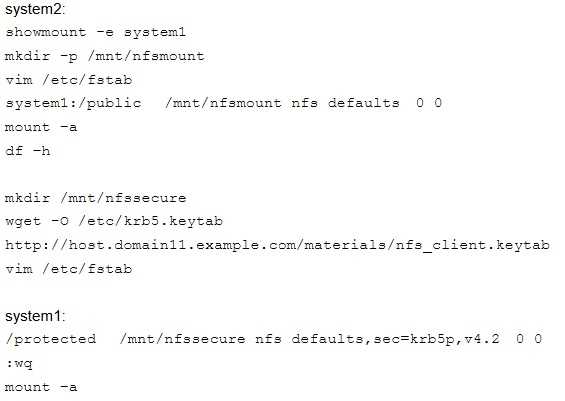
Question 12
CORRECT TEXT
RHCE Test Configuration Instructions
Information for the two systems you will use in test is the following:
system1.group3.example.com: is one of the main sever. system2.group3.example.com:
mainly used as a client.
Password for both of the two systems is atenorth
System’s IP is provided by DHCP, you can regard it as normal, or you can reset to Static IP
in accordance with the following requirements:
system1.group3.example.com: 172.24.3.5
system2.group3.example.com: 172.24.3.10
The subnet mask is 255.255.255.0
Your system is a member of DNS domain group3.example.com. All systems in DNS domain
group3.example.com are all in subnet 172.24.3.0/255.255.255.0, the same all systems in this
subnet are also in group3.example.com, unless specialized, all network services required to
be configured can be accessed by systems of domain group3.
host.group3.example.com provides a centralized authentication service domain
GROUP3.EXAMPLE.COM, both system1 and system2 have already been pre-configured to
be the client for this domain, this domain provides the following user account:
Firewall is enabled by default, you can turn it off when deemed appropriate, other settings
about firewall may be in separate requirements.
Your system will be restarted before scoring, so please ensure that all modifications and
service configurations you made still can be operated after the restart without manual
intervention, virtual machine instances of all examinations must be able to enter the correct
multi-user level after restart without manual assistance, it will be scored zero if the test using
virtual machine system cannot be restarted or be properly restarted.
Corresponding distribution packages for the testing using operating system Red Hat
Enterprise Linux version can be found in the following link:
http://server1.group3.example.com/rhel
Part of the requirements include host security, ensure your host security limit does not
prevent the request to allow the host and network, although you correctly configured the
network service but would have to allow the host or network is blocked, this also does not
score.
You will notice that some requirements which clearly do not allow services be accessed by
service domain my133t.org, systems of this domain are in subnet 172.25.1.0/252.255.255.0,
and systems of these subnets also belong to my 133t.org domain.
PS: Notice that some test questions may depend on other exam questions, for example, you
might be asked to perform a series of restrictions on a user, but this user creation may be
required in other questions. For convenient identification, each exam question has some radio
buttons to help you identify which questions you have already completed or not completed.
Certainly, you do not need to care these buttons if you don’t need them.
Implement/configure a Web Service.
Configure a site http://systeml. domain11.example.com/ on the system1, then execute the
following steps:
(1) Download file from http://rhgls.domain11.example.com/materials/station.html and
rename this files index.html, don’t modify the file contents;
(2) Copy the file index.html to your web server's DocumentRoot directory
(3) Clients from domain group3.example.com can access to this web service
(4) Clients from domain my133t.org deny access to this web service
Answer:
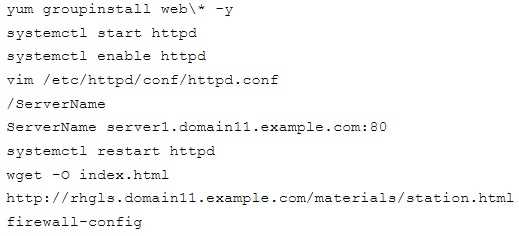
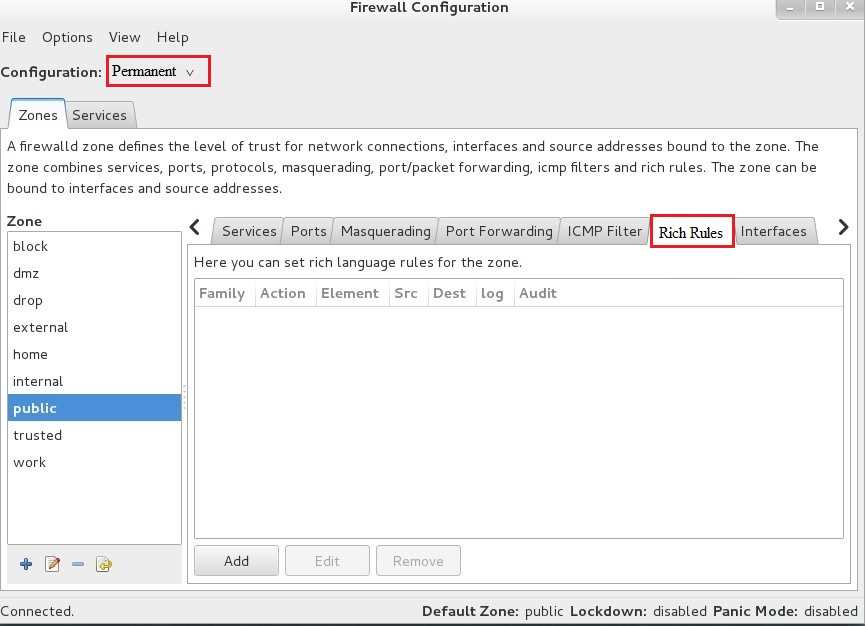
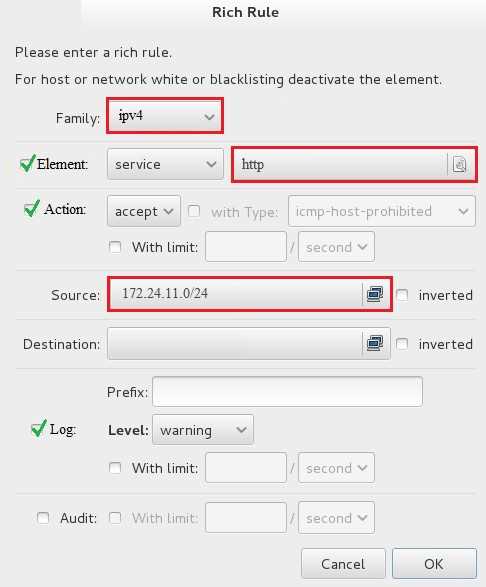
systemctl restart firewalld
Question 13
CORRECT TEXT
RHCE Test Configuration Instructions
Information for the two systems you will use in test is the following:
system1.group3.example.com: is one of the main sever. system2.group3.example.com:
mainly used as a client.
Password for both of the two systems is atenorth
System’s IP is provided by DHCP, you can regard it as normal, or you can reset to Static IP
in accordance with the following requirements:
system1.group3.example.com: 172.24.3.5
system2.group3.example.com: 172.24.3.10
The subnet mask is 255.255.255.0
Your system is a member of DNS domain group3.example.com. All systems in DNS domain
group3.example.com are all in subnet 172.24.3.0/255.255.255.0, the same all systems in this
subnet are also in group3.example.com, unless specialized, all network services required to
be configured can be accessed by systems of domain group3.
host.group3.example.com provides a centralized authentication service domain
GROUP3.EXAMPLE.COM, both system1 and system2 have already been pre-configured to
be the client for this domain, this domain provides the following user account:
Firewall is enabled by default, you can turn it off when deemed appropriate, other settings
about firewall may be in separate requirements.
Your system will be restarted before scoring, so please ensure that all modifications and
service configurations you made still can be operated after the restart without manual
intervention, virtual machine instances of all examinations must be able to enter the correct
multi-user level after restart without manual assistance, it will be scored zero if the test using
virtual machine system cannot be restarted or be properly restarted.
Corresponding distribution packages for the testing using operating system Red Hat
Enterprise Linux version can be found in the following link:
http://server1.group3.example.com/rhel
Part of the requirements include host security, ensure your host security limit does not
prevent the request to allow the host and network, although you correctly configured the
network service but would have to allow the host or network is blocked, this also does not
score.
You will notice that some requirements which clearly do not allow services be accessed by
service domain my133t.org, systems of this domain are in subnet 172.25.1.0/252.255.255.0,
and systems of these subnets also belong to my 133t.org domain.
PS: Notice that some test questions may depend on other exam questions, for example, you
might be asked to perform a series of restrictions on a user, but this user creation may be
required in other questions. For convenient identification, each exam question has some radio
buttons to help you identify which questions you have already completed or not completed.
Certainly, you do not need to care these buttons if you don’t need them.
Configure Security Web Service
Configure a TLS encryption for the site http://systeml.domain11.example.com, encrypt/, get
a signed certificate from http://host.domain11.example.com/materials/system1.crt.
Get the certificate key from http://host.domain11.example.com/materials/system1.key. Get
the signature authorization information of the certificate from
http://host.domain11.example.com/materials/domain11.crt
Answer:
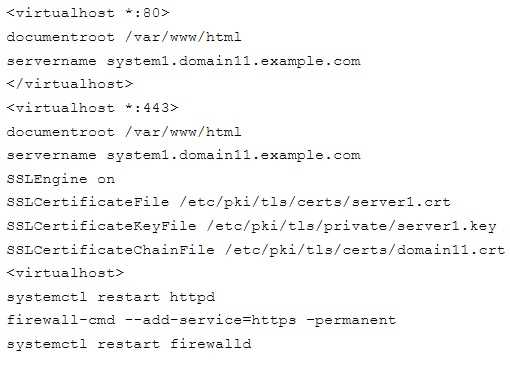
Question 14
CORRECT TEXT
RHCE Test Configuration Instructions
Information for the two systems you will use in test is the following:
system1.group3.example.com: is one of the main sever. system2.group3.example.com:
mainly used as a client.
Password for both of the two systems is atenorth
System’s IP is provided by DHCP, you can regard it as normal, or you can reset to Static IP
in accordance with the following requirements:
system1.group3.example.com: 172.24.3.5
system2.group3.example.com: 172.24.3.10
The subnet mask is 255.255.255.0
Your system is a member of DNS domain group3.example.com. All systems in DNS domain
group3.example.com are all in subnet 172.24.3.0/255.255.255.0, the same all systems in this
subnet are also in group3.example.com, unless specialized, all network services required to
be configured can be accessed by systems of domain group3.
host.group3.example.com provides a centralized authentication service domain
GROUP3.EXAMPLE.COM, both system1 and system2 have already been pre-configured to
be the client for this domain, this domain provides the following user account:
Firewall is enabled by default, you can turn it off when deemed appropriate, other settings
about firewall may be in separate requirements.
Your system will be restarted before scoring, so please ensure that all modifications and
service configurations you made still can be operated after the restart without manual
intervention, virtual machine instances of all examinations must be able to enter the correct
multi-user level after restart without manual assistance, it will be scored zero if the test using
virtual machine system cannot be restarted or be properly restarted.
Corresponding distribution packages for the testing using operating system Red Hat
Enterprise Linux version can be found in the following link:
http://server1.group3.example.com/rhel
Part of the requirements include host security, ensure your host security limit does not
prevent the request to allow the host and network, although you correctly configured the
network service but would have to allow the host or network is blocked, this also does not
score.
You will notice that some requirements which clearly do not allow services be accessed by
service domain my133t.org, systems of this domain are in subnet 172.25.1.0/252.255.255.0,
and systems of these subnets also belong to my 133t.org domain.
PS: Notice that some test questions may depend on other exam questions, for example, you
might be asked to perform a series of restrictions on a user, but this user creation may be
required in other questions. For convenient identification, each exam question has some radio
buttons to help you identify which questions you have already completed or not completed.
Certainly, you do not need to care these buttons if you don’t need them.
Configure the Virtual Host.
Expand your web server on the system1, create a virtual host for the site
http://www.domain11.example.com then perform the following steps:
1. Set the DocumentRoot to /var/www/virtual from
http://rhgls.domain11.example.com/materials/www.html
2. Download a file, rename as index.html, don’t modify file index.html content
3. Put the file index.html under the directory DocumentRoot of Virtual Host
4. Ensure that user Andy can create files under directory /var/www/virtual
Note: original site http://systeml.domian11.example.com/ must still be able to be accessed.
Name server domain11.example.com provide the domain name resolution for host name of
www.domain11.example.com
Answer:

Question 15
CORRECT TEXT
RHCE Test Configuration Instructions
Information for the two systems you will use in test is the following:
system1.group3.example.com: is one of the main sever. system2.group3.example.com:
mainly used as a client.
Password for both of the two systems is atenorth
System’s IP is provided by DHCP, you can regard it as normal, or you can reset to Static IP
in accordance with the following requirements:
system1.group3.example.com: 172.24.3.5
system2.group3.example.com: 172.24.3.10
The subnet mask is 255.255.255.0
Your system is a member of DNS domain group3.example.com. All systems in DNS domain
group3.example.com are all in subnet 172.24.3.0/255.255.255.0, the same all systems in this
subnet are also in group3.example.com, unless specialized, all network services required to
be configured can be accessed by systems of domain group3.
host.group3.example.com provides a centralized authentication service domain
GROUP3.EXAMPLE.COM, both system1 and system2 have already been pre-configured to
be the client for this domain, this domain provides the following user account:
Firewall is enabled by default, you can turn it off when deemed appropriate, other settings
about firewall may be in separate requirements.
Your system will be restarted before scoring, so please ensure that all modifications and
service configurations you made still can be operated after the restart without manual
intervention, virtual machine instances of all examinations must be able to enter the correct
multi-user level after restart without manual assistance, it will be scored zero if the test using
virtual machine system cannot be restarted or be properly restarted.
Corresponding distribution packages for the testing using operating system Red Hat
Enterprise Linux version can be found in the following link:
http://server1.group3.example.com/rhel
Part of the requirements include host security, ensure your host security limit does not
prevent the request to allow the host and network, although you correctly configured the
network service but would have to allow the host or network is blocked, this also does not
score.
You will notice that some requirements which clearly do not allow services be accessed by
service domain my133t.org, systems of this domain are in subnet 172.25.1.0/252.255.255.0,
and systems of these subnets also belong to my 133t.org domain.
PS: Notice that some test questions may depend on other exam questions, for example, you
might be asked to perform a series of restrictions on a user, but this user creation may be
required in other questions. For convenient identification, each exam question has some radio
buttons to help you identify which questions you have already completed or not completed.
Certainly, you do not need to care these buttons if you don’t need them.
Configure the Access to the Web Content
Create a directory private under the directory DocumentRoot in the web server on the
system1, requirements are the following:
Download a file copy to this directory from
http://rhgls.domain11.example.com/materials/private.html
and rename it as
index.html.
Don’t make any changes to this file content
Any users from the system1 can browse the content of the private, but cannot access
this directory content through other systems
Answer:
